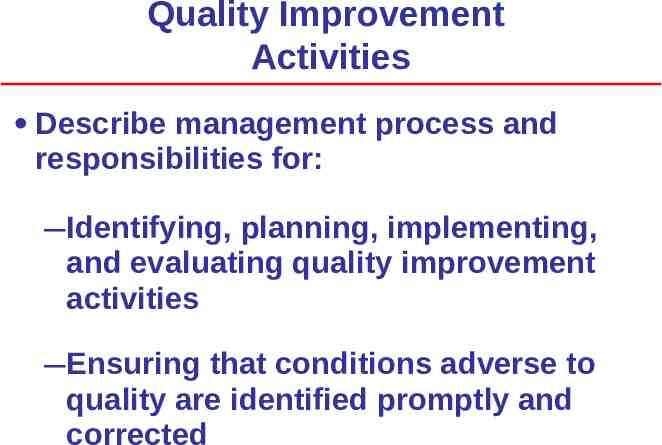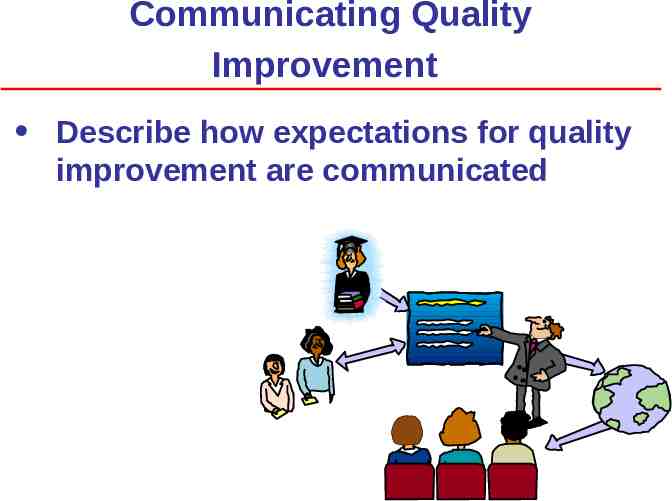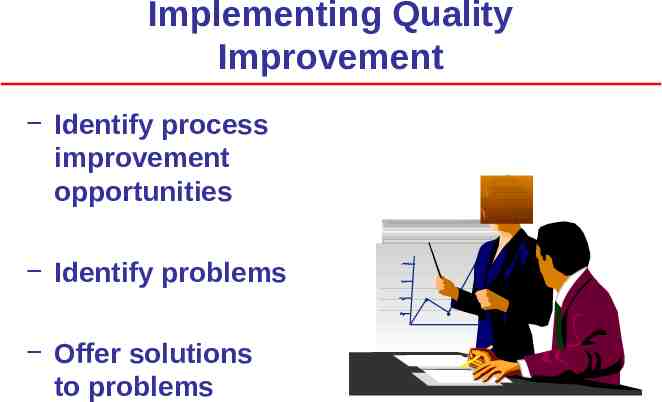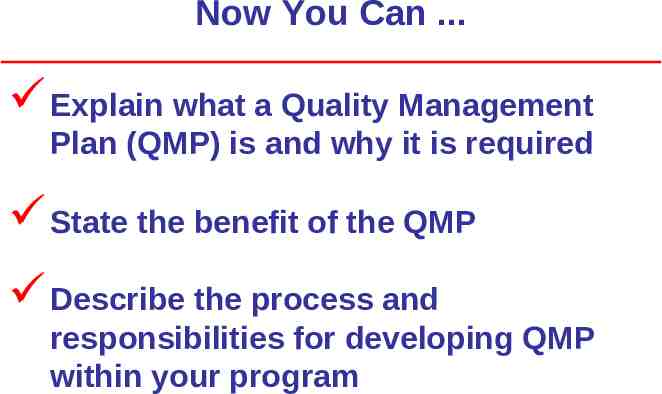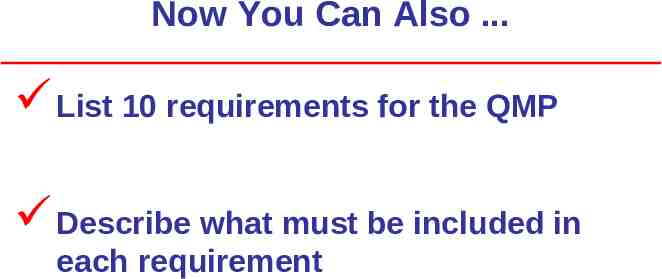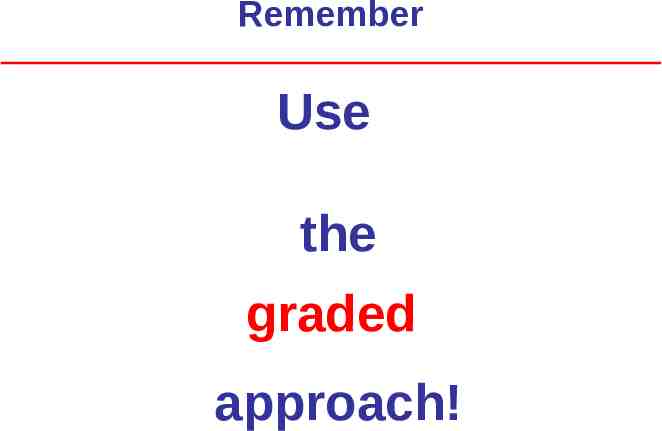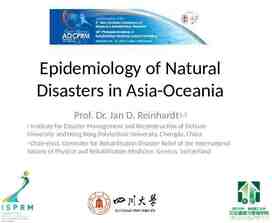QUALITY MANAGEMENT PLAN OVERVIEW
96 Slides1.22 MB
QUALITY MANAGEMENT PLAN OVERVIEW
Course Goals At the conclusion of this training, you will be able to: – Explain the basic considerations for Quality System design – Explain what a Quality Management Plan (QMP) is and why it is required – Discuss the ten elements of a QMP and the topics to cover in each – Explain the graded approach to designing a QMP
Why Are You Here? Any organization conducting environmental programs by or on behalf of EPA must have a documented quality system The QMP documents that quality system You help develop a QMP.
How is an organization vulnerable if inadequate data are collected?
What Is A Quality System? A framework of management and technical practices that assure that environmental data used to support decisions are: Of adequate quality and usability for their intended purpose Defensible
Quality System Description Computer Hardware/Software Quality Improvement Environmental Data Operations Assessment Personnel Qualifications/Training Implementation of Work Processes Procurement Adequate Data Quality Records/Documentation Management/Organization Planning
Common Steps in Quality System Design Prepare an overview of the current organization and its environmental data operations Identify existing Quality System components or tools Document existing procedures as appropriate Develop procedures where necessary Document the Quality System design
System Overview Org. Data Use Technical Activities Responsibility Quality System Tools Used Notes
Questions to Ask How does your organization use data (data generator, decision maker, regulatory)? What is the scope of technical activities within your organization (monitoring, regulatory actions, inspections, characterizations, program oversight)? Who is responsible for planning, implementing, and assessing these technical activities? What tools are already in use or are mandated (QAPPs, SOPs, TSAs)?
Graded Approach QA and QC requirements commensurate with: Importance of work Available resources Unique needs of organization Consequences of potential decision errors
Tips for Design and Implementation Don't delegate responsibility for success of the Quality System too low in organization In larger organizations, avoid communicating QMP requirements to everyone all at once Use value added assessments rather than rigid audits Build success measures into the system so that you will know when it is working well
QMP Requirements Overview
QMP Requirement All work performed by EPA organizations and by external organizations funded by EPA that involves acquisition of environmental data generated from direct measurement activities, collected from other sources, or compiled from computerized data bases and information systems shall be covered by an Agencyapproved QMP.
Internal and External Requirements Internal: EPA Order 5360.1 A2 2000 External: – 48 CFR Part 46 (contracts) – 40 CFR Part 30, 31, and 35 (assistance agreements) – Other (e.g., consent agreements in enforcement actions)
QMP Purpose The QMP documents what you are going to do, how you are going to do it, and how you know you did it.
Important Terms Quality Management Quality Assurance Quality Control
Scope of QMP Must reflect or emphasize actual practices, not planned practices Should use the graded approach Should be constructed and written so its effectiveness can be assessed
Revision QMP must be kept accurate and up-to- date in accordance with changes in QA policy and procedures Notify all appropriate personnel about changes to quality system and QMP
Revision (Cont’d) Internal: Submit revisions made during year to the Quality Staff with QA Annual Report and Work Plan. External: Submit revisions to the designated EPA official as a report when they occur. If changes are significant, submit entire QMP.
General Requirements
10 QMP Requirements 1. Management and Organization 2. Quality System Components 3. Personnel Qualifications and Training 4. Procurement of Items and Services 5. Documents and Records
10 QMP Requirements (Cont'd) 6. Computer Hardware and Software 7. Planning 8. Implementation of Work Processes 9. Assessment and Response 10.Quality Improvement
Approval Page Approval page signatures – Management – QA Manager of organization – Quality Staff Director (internal) – Senior EPA Official for Quality (internal) – Responsible EPA official (external) May be either part of title page or separate sheet following title page
If Not Applicable If element is not applicable to an organization's quality system, a statement about why it is not must be included in QMP
Management and Organization
Overview: Management and Organization A description of: QA Policy Technical activities Organizational structure Dispute resolution Staff roles, responsibilities, and authorities Quality System implementation
QA Policy A statement of the organization's policy on quality assurance, including: Importance of QA and QC to organization and why General objectives/goals of Quality System Policy for resource allocation for the Quality System
Organization Chart An organization chart must: – Identify all components of the organization – Identify the position and lines of reporting for QA Manager and any QA staff – Show independence of the QA Manager from groups generating, compiling, and evaluating environmental data
Responsibilities and Authorities Discuss the responsibilities and authorities of: QA Manager Any other QA staff
Technical Activities Discuss the technical activities or programs supported by the quality system – Specific programs that require quality management controls – Where oversight of extramural programs is needed to assure data quality – Where internal coordination of QA and QC activities needs to occur
Process for Resolving Disputes - Internal Only Discuss the organization's process for resolving disputes regarding: Quality system requirements applicability QA and QC procedures application Assessments Corrective actions
Quality System Implementation Discuss how management will ensure that applicable elements of the Quality System are understood and implemented in all environmental programs
Quality System Components
Overview: Quality System Components 1. Discuss principal components of Quality System and tools used to manage the system – What components comprise Quality System – What tools are used to manage Quality System – Who uses them and how
Quality System Components (Cont'd) 2. List parts of the organization that are required to prepare QMPs 3. Discuss the review and approval process for QMPs from external organizations
ORGANIZATION/PROG RAM POLICY/REGULATIONS Consensus Standards ANSI/ASQC E4 ISO 9000 Series Contracts - 48 CFR 46 Assistance Agreements 40 CFR 30, 31, and 35 EPA Order 5360.1 EPA Manual 5360 EPA Program & Regional Policy Quality System Documentation (e.g., QMP) Supporting System Elements (e.g., Procurements, Computer Hardware/Software) Training/Communication (e.g., Training Plan, Conferences) System s Assessments (e.g., QSAs) Annual Review and Planning (e.g., QAARWP) Systematic Planning (e.g., DQO Process) PROJECT External Policies Internal EPA Policies Conduct Study/ Experiment Standard Operating Procedures QA Project Plan PLANNING Technical Assessments IMPLEMENTATION Defensible Products and Decisions Data Verification & Validation Data Quality Assessment ASSESSMENT
Quality System “Tools” QMPs Management Assessments - Self and Independent Technical Assessments Systematic Planning Standard Operating Procedures (SOPs) Quality Assurance Project Plans (QAPPs) Data Quality Assessments
Personnel Qualifications and Training
Overview: Personnel Qualification and Training Describe organization's process for: Establishing training requirements Identifying training needs Assigning training priorities Meeting training needs
Three Areas to Cover 1. Training policy 2. Training processes 3. Critical training documentation Hello, everyone! Hello, everyone!
Policy State the policy regarding training for management and staff
Processes Describe processes and management/staff responsible for: – Identifying statutory, regulatory, or professional certifications required – Identifying, designing, performing, and documenting training Technical Quality Project management
Document Training Describe how staff proficiency in critical technical disciplines is maintained and documented
Procurement of Items and Services
Overview: Procurement of Items and Services Describe organization's process for ensuring that suppliers provide items and services that: – Are of known and documented quality – Meet the technical requirements
Four Areas to Cover 1. Review and approval of procurement documents 2. Review and approval of QA responses to solicitations 3. Objective evidence of adequate quality from suppliers 4. QA document review and approval
Review and Approval of Procurement Documents Describe process and responsibilities for ensuring that documentation clearly states: – Item or service required – Technical and quality requirements – Quality System elements that the supplier is responsible for – How supplier's conformance to requirements will be verified
Review and Approval of QA Responses to Solicitations Describe roles, responsibilities, and process for review and approval of responses to solicitations to ensure: – That all technical and quality requirements are satisfied – That there is adequate evidence of supplier's capability to satisfy EPA Quality System requirements
Quality From Suppliers Describe process for determining adequate quality from suppliers, including: – How procurement sources are evaluated and selected – How and when source inspections are used – How deliverables are examined for conformance to specifications
QA Document Review and Approval Describe roles, responsibilities, processes and policies for: – Review and approval of mandatory quality related documentation – Delegation of review and approval of mandatory quality-related documentation – Ensuring that EPA quality-related contracting policies are satisfied
Documents and Records
Overview: Documents and Records Discuss procedures for documents and records: – Timely preparation – Review – Approval – Issuance – Use – Control – Revision – Maintenance
Document Work Plan – Describes – Defines – Specifies – Reports – Certifies Sampling & Analysis Plan Any compilation of information that:
Record A completed document that provides objective evidence of an item or process.
Identify Documents and Records Describe or reference process for identifying quality-related documents and records requiring version and release control
QA-Related Documents and Records Describe or reference process by which all QA-related documents and records are: – Accessible – Protected from damage and deterioration – Subject to retention requirements – Prepared, reviewed, and approved – Issued and revised
Compliance Describe or reference process for ensuring compliance with all statutory, contractual, and assistance agreement requirements for records from environmental programs
Computer Hardware and Software
Overview: Computer Hardware and Software The QMP must describe QA and QC processes for the use of computer hardware and software to support environmental data operations
General Requirements Computer hardware must be appropriate for its intended application Computer programs must be developed using an approved software development methodology
Examples of Hardware Covered Data acquisition/logging systems Computers used with analytical instruments Automated sampling systems in which system failure would adversely affect quality and potential usability of collected data for decisions
Examples of Software Covered Programs Models Data bases Data analysis systems
Hardware QA and QC Processes Describe or reference process for ensuring that computer hardware used in environmental programs meets technical requirements and quality expectations Describe or reference how changes to hardware will be controlled to assess impact of change on performance
Software Development QA and QC Processes Describe or reference process for: – Developing computer software – Validating, verifying, and documenting software for its use – Assuring that software meets requirements of user
IRM Policies Describe or reference process for ensuring: 1. That data and information produced and collected by computers meet applicable information resource management requirements and standards
IRM Policies 2. That applicable EPA requirements for information resources management are addressed, including: Year 2000 compliance (Chapter 5) Security (Chapter 8) Privacy requirements (Chapter 11)
Planning
Overview: Planning Description of process for planning environmental programs Discussion of QAPP process Discussion of organization's secondary data policy
Systematic Planning Use systematic planning process based on scientific method Apply the principle of graded approach and common sense
Systematic Planning Requirements Describe process used for general project planning, including: – How it is accomplished – How planning will be documented – Who uses planning "tools" – Roles and responsibilities of management and staff
Quality Assurance Project Plans (QAPPs) Describe process for: Developing Reviewing Approving Implementing Revising the QAPP
Secondary Data Discuss process for evaluating and qualifying secondary data Describe application of any statistical methods used
Implementation of Work Processes
Overview: Implementation of Work Processes Describe process for implementing work within organization – Procedures for ensuring work is performed according to plan – Procedures for routine, standardized, special, or critical operations – Procedures for controlling and documenting the release, change, and use of planned procedures
Developing and Implementing Procedures Describe process for: – Ensuring that work is performed according to plan – Developing and implementing procedures for appropriate routine, standardized or special operations, including: Identifying operations needing procedures Preparation of procedures – Reviewing and approving procedures
Planned Procedures Describe measures for controlling planned work processes or procedures: – Their release – Their change – Their use
Controlling Measures Measures should provide for: – Necessary approvals – Specific times and points for implementing changes – Removal of obsolete documentation from work area – Verification that changes are made as prescribed
Assessment and Response
Overview: Assessment and Response Describe: – How and by whom assessments of environmental programs are planned, conducted, and evaluated – Process by which management determines: Assessment activities and tools appropriate for a particular project Expected frequency of use
Examples of Assessment Tools Management systems reviews Surveillance Technical systems audits Performance evaluations Audits of data quality Peer reviews and technical reviews Readiness reviews Data quality assessments
Two General Types of Assessment 1. Management 2. Technical
Assessment Activities Describe process: – For planning, conducting, and evaluating assessments – By which management chooses the appropriate assessment for a particular project
Assessment Activities (Cont'd) Describe: – How frequency of assessments is determined – Process for reporting and responding to results – Responsibilities, levels of participation, and authorities for all management and staff participating in assessment process
Assessor Qualifications Assessor qualifications – Technically knowledgeable – No real or perceived conflict of interest
Assessor Authority Describe how personnel conducting assessments will have: – Sufficient authority – Access to programs and managers – Access to documents and records – Organizational freedom
Assessment Results Describe process for review of assessment results Include: – Documentation of results – Reports to management – Management review procedures
Response Actions Describe process for responding to findings: – How corrective actions will be taken – When they will be taken – By whom they will be taken Describe how effectiveness of response will be determined and documented
Quality Improvement
Overview: Quality Improvement Describe: – How organization will detect and prevent quality problems and ensure continual quality improvement – Communication of expectations about quality improvement to staff
Quality Problems Often inherent in existing management and technical systems Workers by themselves have little control over eliminating these problems or improving performance Action is required from management to commit to quality improvement
Quality Improvement Activities Describe management process and responsibilities for: –Identifying, planning, implementing, and evaluating quality improvement activities –Ensuring that conditions adverse to quality are identified promptly and corrected
Communicating Quality Improvement Describe how expectations for quality improvement are communicated
Implementing Quality Improvement Identify process improvement opportunities Identify problems Offer solutions to problems
Now You Can . Explain what a Quality Management Plan (QMP) is and why it is required State the benefit of the QMP Describe the process and responsibilities for developing QMP within your program
Now You Can Also . List 10 requirements for the QMP Describe what must be included in each requirement
Remember Use the graded approach!


























































































